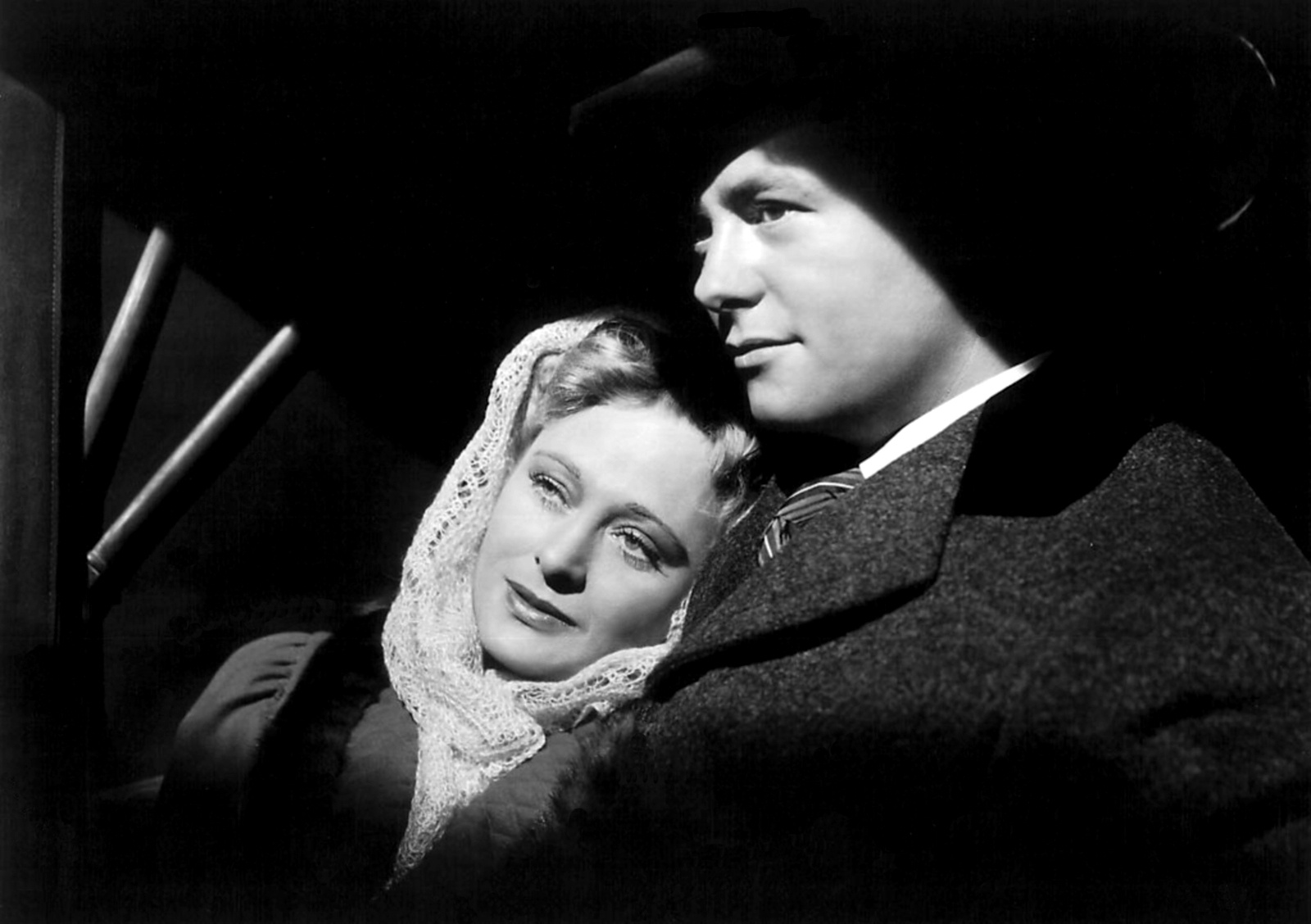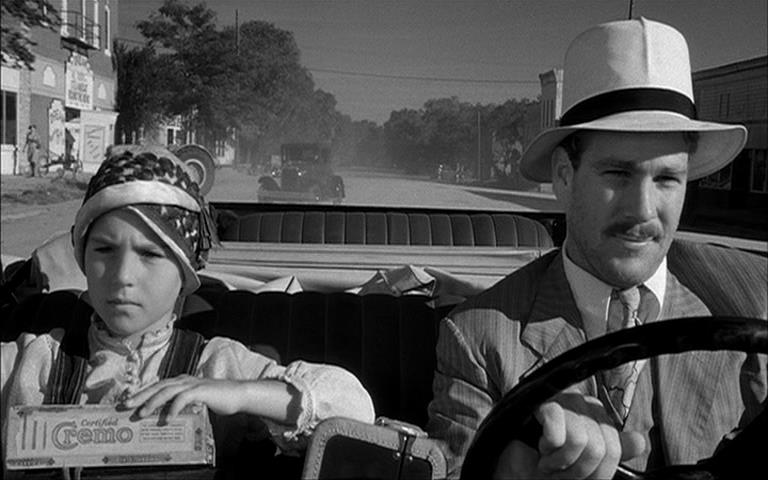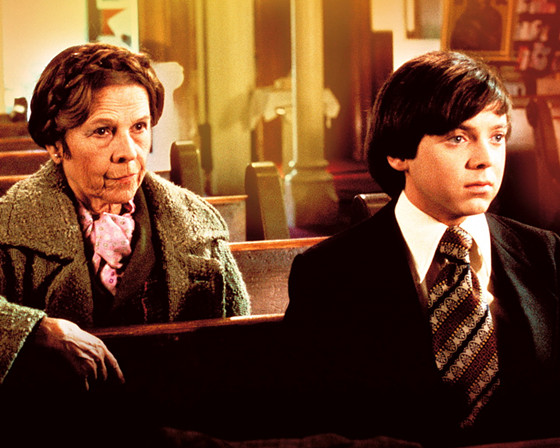6. The Magnificent Ambersons (1942, Orson Welles)
In one interview, Wes Anderson said of Orson Welles, “He’s not particularly subtle. He likes the big effect, the very dramatic camera move, the very theatrical device. I love that! And then also, he loves actors, and he is an actor himself, and he always created great characters that also tend to be larger than life.”
Throughout his career, Orson Welles remained a theatre man. He made some worthy entries into the genre of Film Noir during its golden age but his strongest films are rooted in the tradition of quality theatre, meaning tragedy, meaning Man’s fall from greatness. Despite working a much more comic vein, Wes Anderson has explored the anxieties of decline and disillusionment with greatness in Rushmore’s Mr. Blume, all of the Tenenbaums, and Steve Zissou in The Life Aquatic. Similarly, the affluent Whitman brothers in The Darjeeling Limited are grieving the loss of their father. We don’t know if the dead Whitman patriarch was great but he was at least affluent—a sufficient proxy for greatness in American films.
Since you are reading this article one can deduce that you understand English and have a computer, thus you have already seen Citizen Kane at least once. So instead let’s talk about Welles’ second most successful picture, The Magnificent Ambersons. The story follows the fates of two prominent families in small town America during the advent of the automobile. Adapted from a Booth Tarkington’s novel of the same name, The Magnificent Ambersons has all the technical qualities of Citizen Kane (the deep focus images, high contrast lighting, excellent score, and Orson Welles’ rich baritone). What it doesn’t have is a Rosebud. The studio “ruined” the ending by reconciling key characters. In all fairness, Orson Welles’ original ending doesn’t sound very satisfying either. Not everyone gets a Rosebud.
Wes Anderson and his co-writer on the Royal Tenenbaums, Owen Wilson, have said that The Magnificent Ambersons was their story’s model, along with the novella Franny and Zooey by J.D. Salinger. Both films are primarily set in a grand old house. The houses look the same in many shots. But aside from this one film among the nine features Wes Anderson has made as of this writing, there are cinemagraphic traits that can be traced back to Orson Welles. Both directors exploit the distortion caused by wide-angle lenses. Both go for the visually bold statement that sometimes lets the mode overtake the message.
When a director working in the 21st century says that he was influenced by Orson Welles, one is apt to wonder why the director has so coldly cut Auguste and Louis Lumière. And why hasn’t D. W. Griffith been name-checked? Welles is the revolutionary whose boldness has become orthodoxy. But he is an essential figure in the line of directors that have influenced Wes Anderson. The connection is strongest through our next entry, the Wellesian disciple and biographer Peter Bogdanovich.
7. Paper Moon (1973, Peter Bogdanovich)
There is an overt fondness for retro style in all of Wes Anderson’s movies after Bottle Rocket. What Bottle Rocket lacks in style cues from Paper Moon is makes up for in amusing bickering between partners in crime. Ryan O’Neal and his real-life daughter Tatum play con-man “Moze” Pray and his recently orphaned collaborator Addie. They drive around grifting country folk in Kansas and Missouri.
It is the great depression, and there seems to be enough widows around for O’Neal’s “Moze” Pray to make a living convincing them that their deceased husband had ordered an ornate personalize Bible with a “balance owed”. In Bottle Rocket, Luke Wilson and his real-life brother Owen play two friends-like-brothers who want to become professional thieves. In both Paper Moon and Bottle Rocket the key protagonists conspire to keep their schemes a secret, and struggle with crossed loyalties.
As the 30s looked to an audience in the 70s, so the quasi-60s and 70s of The Royal Tenenbaums, The Life Aquatic, Moonrise Kingdom, and key scenes from The Grand Budapest Hotel look to us. Peter Bogdanovich used black and white film to give his Depression era movie the right feel. As a film school geek of the 70s, Bogdanovich wanted to emulate the films of his heroes. Orson Welles, who encouraged Bogdanovich to change the title to Paper Moon, extolled the virtues of black and white film at a time when B-movies had moved to color film stock. Art and Design fans of Wes Anderson have their own out-moded forms to fetishize, like the use of Futura script.
What makes Paper Moon an essential predecessor to Wes Anderson’s film worlds is the parity of children and adults. Not unlike the Peanuts cartoons, Paper Moon has no wise elders to rely upon for guidance. The adults are as childish as the children are precocious. The result is character arcs where no one is privileged to know what others will find out through experience. Everyone is gaining their hard won experience at the same time, regardless of age.
8. The Graduate (1967, Mike Nichols)
The adroit use of pop songs might have antecedents in other films, but it is in The Graduate that the sensibility is fully formed—a sensibility that Wes Anderson excels at.
The Graduate follows Ben Braddock (Dustin Hoffman) who has done amazingly well at university and is staring into the abyss of post-graduate life. To fill the void, he slides into an extramarital affair with Mrs. Robinson, the wife of his father’s law partner. It is a passionless affair until he takes Mrs. Robinson’s daughter on an obligatory date and falls in love with her.
The Graduate has masterfully composed images in a widescreen format (2.35 : 1 with Panasonic lens and Technicolor), that Wes Anderson has made a hallmark of his own style (in the same technical specs). Take another look at the pool scene where Dustin Hoffman’s character is obliged to try out his new scuba gear. It parallels the pool scene in Rushmore, where Bill Murray’s character flees his sons’ birthday party while his wife is flirting with a much younger man, a young Dustin Hoffman lookalike, by jumping in the pool. The homage is clever and the film format allows the close-ups to isolate the Hoffman/Murray character amid an expanse of blue water.
Lastly, there is the ending. Dustin Hoffman’s Ben has chased the girl he loves right to the altar. They battle their way through parents, expectations, conventions, and out to a waiting bus. They get on elated but it takes only a few minutes as “The Sound of Silence” cloaks the characters’ eroding confidence to throw the resolution of their story into question. The result is satisfying without being pat. It neither confirms nor denies that the kids are alright. Wes Anderson’s endings also employ a lush pop song. And as of this reporting, no authority has confirmed or denied that Max Fisher, the Tenenbaums, Steve Zissou, the Whitmans, the animals of Fantastic Mr. Fox, etc, have had a happily ever after.
9. Harold and Maude (1971, Hal Ashby)
This film would not exist if Mike Nichols hadn’t made the Graduate four years prior. They both, like Rushmore, deal with a young man’s relationship to a much older woman. Here the similarities end. In The Graduate, Mrs. Robinson comes to represent all that is dead-eyed and bitter in the world of adults. She uses Ben for her sexual interests to assuage her affluent, suburban housewife ennui. Though it is 1967, she is a 1950s creature.
Maude (Ruth Gordon) is not particularly interested in Harold’s sexual promise, nor is she stricken with ennui. In fact, just the opposite. In a curious twist on what today’s commentators are calling the Manic Pixie Dream Girl, Maude is the Manic Pixie Dream Octogenarian. It is through her friendship that Harold learns to “live live live!”
No conformist hausfrau, we learn that Maude was an antiwar protestor before it was cool. But since it is 1971 (post-Kent State shooting), she has matured beyond political protest towards a more personal kind of protest. She liberates private property in the form of various cars and public property like a tree that needs better air than the city can provide. She is a nude model and she invents quirky machines. She’s an artist (style nods to Marc Chagall and Jean Arp), a free spirit, and the fact that she is a Holocaust survivor is intended to lend weight to her otherwise batty behavior.
Different still is Miss Cross, who has the least carnal appetite of the three women under consideration. She is also much younger, a new widow cheated of the best years of her marriage…or at least the earliest years. Because Max is a minor, making him younger than Ben or Harold, he only manages to steal a kiss from Miss Cross. Her affair with Mr. Blume, despite the rivalry it sparks between him and Max, is neither exploitive like Mrs. Robinson nor inspiring like Maude.
What is a commonality between Hal Ashby’s film and the films of Wes Anderson is the treatment of violence. Harold has an immense talent for faking his own death. He does it several times in the 90some minute movie and each shtick is delightfully morbid. Wes Anderson has a few instances of realistic violence, meaning that someone gets hurt and it’s not funny, but by and large he plays it for laughs. The Grand Budapest Hotel is likely his most grotesque entry thus far.
10. A Hard Day’s Night (1964, Richard Lester)
When it was suggested to Richard Lester that his work of pop iconography, the Beatles vehicle A Hard Day’s Night, made him the father of MTV he demanded a paternity test. This is exactly the sort of cheeky wit one finds in the director’s early work. He went on to make some films that are, shall we say, a mark of the times. The studio system was in full collapse and the New Hollywood model had yet to rise from the ashes.
However, his early 60s work with the Beatles is the stuff of legend. One such legend is told by the poet Allen Ginsberg who claimed that when he heard the Beatles for the first time, he knew the war was really over. That buoyancy so long unavailable in the stern years of World War Two and its chilling aftermath is reflected in the rollicking editing of A Hard Day’s Night. It is perfectly matched to the Beatles’ music, before acid and India brought out their more thoughtful, introspective tunes.
A Hard Day’s Night and the following year’s Help! are farces held together with music. The humor is broad and mischievous. Wes Anderson shares an affinity for such antics, as evidenced in the action sequences from Moonlight Kingdom, the fights in Bottle Rocket, and the entirety of Fantastic Mr. Fox.
At this point, Wes Anderson has become a style unto himself. Indie newcomers pastiche the Anderson aesthetic with reckless abandon, like Son of Rambow (2007), and studied insouciance like Submarine (2010). Recently critics have accused Wes Anderson of making pastiches of his own work, but self-consciousness has been a hallmark of Wes Anderson films since the beginning. As a filmmaker and storyteller focused on his own worlds of imagination, the question is not whether Wes Anderson is going to ever depart from his style but rather, what else and who else is he going to bring into it?
Author Bio: Chris is a 29 year old grant-writer for a meditation retreat center in the Colorado Rockies, but he came here first to make short videos about the center. His favorite directors are Federico Fellini, Kurosawa, Billy Wilder, the Coen Bros., Stanley Kubrick, and Edgar Wright.




